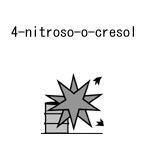| Case Name |
Explosion of a dryer caused due to unexpected reaction of residual alkali |
| Pictograph |

|
| Date |
March 20, 1989 |
| Place |
Yokkaichi, Mie, Japan |
| Location |
Chemical factory |
| Overview |
At a manufacturing plant, 4-nitroso-o-cresol was prepared, cleaned with alkali, rinsed with water, dried, and was left in a nitrogen atmosphere. It exploded under the nitrogen atmosphere after sampling. Alkali remained in the last operation was possibly the cause. |
| Incident |
At a 4-nitroso-o-cresol manufacturing plant, the reaction products were dried and sealed with nitrogen at 20 KPaG after sampling. After one hour and fifteen minutes it exploded. Reaction formula for synthesis of 4-nitroso-o-cresol is shown in Fig3 for reference. |
| Processing |
Manufacture |
| Individual Process |
Drying and desiccation |
| Process Flow |
Fig2.Simplified flow sheet
|
| Chemical Equation |
Fig3.Chemical reaction formula
|
| Substance |
4-nitroso-o-cresol |
| Type of Accident |
Leakage, explosion |
| Sequence |
The dryer was kept under a pressured condition with nitrogen after alkali-cleaning and water-rinsing from the end of the previous year.
Four days before the fire, on March 16th, 1989, the reaction started. The reaction products were cleaned and their thermostability was checked.
On the 18th, two days before the fire, the reaction products were treated in a centrifugal dehydrator.
The solid material was moved to the dryer after dehydration. It was kept in the dryer, pressurized at 20 KPaG with nitrogen, and left until the 20th, the day of the accident.
7:00-8:30 of 20th; drying was executed at normal temperature.
8:30-20:30; high temperature drying was executed.
20:30; the internal pressure was returned to atmospheric pressure using nitrogen and the contents were sampled.
20:45; after sampling, the dryer was stopped, and was compressed with nitrogen to 20 KPaG.
21:59; the gas blew off.
22:00; an explosion occurred. |
| Cause |
The dryer was cleaned with alkali after finishing the previous operation of 4-nitroso-o-cresol, and then rinsed with water to wash away the alkali. However, a small amount of sodium hydroxide remained at that time. The remained sodium hydroxide mixed with 4-nitroso-o-cresol, which was newly synthesized. This triggered a polycondensation reaction locally and generated heat. The products were melted by the heat, and the heat triggered rapid polycondensation. Moreover, through the insulation effect of the un-melted part around the melted portion, a large amount of gas was generated by the reaction at an accelerating rate. The gas leaked from the manhole at the upper part and the room was filled with the gas. Furthermore, the manhole came off and a large amount of gas leaked. The leaked gas ignited and exploded by sparks generated when the manhole came off, static electricity generated when gas blew off or spontaneous ignition of the reaction products. |
| Response |
Fire extinguishing equipment was operated. |
| Countermeasures |
Alkali cleaning of dryers should be prohibited.
Pressure detectors should be duplicated.
Education for operators and an operation manual should be enhanced. |
| Knowledge Comment |
They should have studied the minimum concentration required to trigger polycondensation, if alkali induced the polycondensation. If the concentration was unknown, a separation method should be considered. |
| Background |
Sodium hydroxide contamination caused the accident. However, it is doubtful if the managers understood that sodium hydroxide contamination is dangerous, and whether they educated the operators. 4-nitroso-o-cresol has a tendency toward polycondensation in the coexistence with acid or alkali. If they did not know about this, it was a lack of study. If they knew, there was possibly a problem with process design or operation management. |
| Incidental Discussion |
Alkali always remains even if there is rinsing with water after alkali-cleaning. As rinsing is an extraction operation, complete removal is impossible. Efficiency should be considered. |
| Reason for Adding to DB |
Example of accident caused due to a runaway reaction from material contamination |
| Scenario |
| Primary Scenario
|
Poor Value Perception, Poor Safety Awareness, Inadequate Risk Recognition, Insufficient Analysis or Research, Insufficient Prior Research, Contamination Risk, Misjudgment, Misunderstanding, Nature of Washing, Planning and Design, Poor Planning, Poor Design, Bad Event, Chemical Phenomenon, Abnormal Reaction, Secondary Damage, External Damage, Leakage/Explosion, Loss to Organization, Economic Loss, The Plant Damaged
|
|
| Sources |
Fire and Disaster Management Agency, Explosion in dryer while manufacturing cresol compound -Accident cases of dangerous material -, pp.58-59
High pressure gas safety institute of Japan, high-pressure gas safety overview, p.185(1989)
High pressure gas safety institute of Japan, explosion accident in dryer, Accident case of petroleum refinery and Petrochemical units, pp.186-190(1995)
|
| Physical Damage |
The walls of a slate-roofed four-story plant building blew out. Slates and windows were scattered within a 32-meter radius of the dryer. Damage to a steel frame, windows, dryer, a centrifugal dehydrator, an explosion-proof lamp. |
| Financial Cost |
¥ 1 million (Accident cases of dangerous materials), ¥ 3.3 million (Accident case of Petroleum refinery and Petrochemical unit) |
| Notes |
Insufficient prior investigation |
| Field |
Chemicals and Plants
|
| Author |
WADA, Yuji (National Institute of Advanced Industrial Science and Technology)
TAMURA, Masamitsu (Center for Risk Management and Safety Sciences, Yokohama National University)
|
|